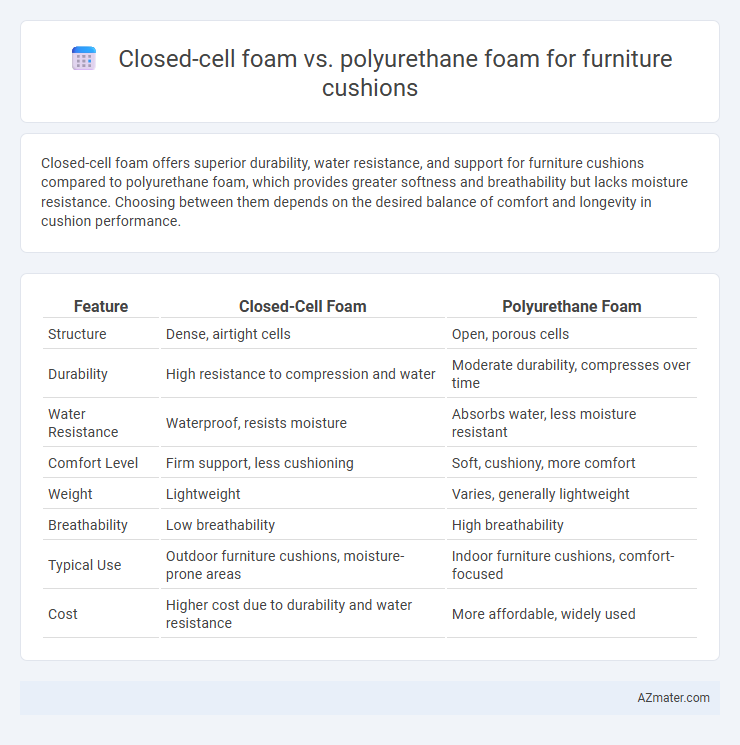Closed-cell foam offers superior durability, water resistance, and support for furniture cushions compared to polyurethane foam, which provides greater softness and breathability but lacks moisture resistance. Choosing between them depends on the desired balance of comfort and longevity in cushion performance.
Table of Comparison
| Feature | Closed-Cell Foam | Polyurethane Foam |
|---|---|---|
| Structure | Dense, airtight cells | Open, porous cells |
| Durability | High resistance to compression and water | Moderate durability, compresses over time |
| Water Resistance | Waterproof, resists moisture | Absorbs water, less moisture resistant |
| Comfort Level | Firm support, less cushioning | Soft, cushiony, more comfort |
| Weight | Lightweight | Varies, generally lightweight |
| Breathability | Low breathability | High breathability |
| Typical Use | Outdoor furniture cushions, moisture-prone areas | Indoor furniture cushions, comfort-focused |
| Cost | Higher cost due to durability and water resistance | More affordable, widely used |
Introduction to Furniture Cushion Foams
Closed-cell foam offers superior durability and moisture resistance, making it ideal for furniture cushions exposed to high wear and potential spills. Polyurethane foam provides excellent softness and breathability, enhancing comfort but with less resistance to water absorption compared to closed-cell foam. Selecting the appropriate foam depends on balancing factors such as firmness, resilience, and environmental exposure to optimize cushion performance and longevity.
What is Closed-Cell Foam?
Closed-cell foam is a type of foam with densely packed cells that are fully enclosed, providing superior resistance to water, air, and moisture compared to open-cell polyurethane foam. This structure makes closed-cell foam denser, firmer, and more durable, ideal for furniture cushions that require long-lasting support and shape retention. Its high insulation properties and resistance to compression also contribute to enhanced comfort and durability in seating applications.
Understanding Polyurethane Foam
Polyurethane foam is a versatile and widely used material in furniture cushions, known for its flexibility, durability, and comfort. Unlike closed-cell foam, which has a rigid structure and water-resistant properties, polyurethane foam features an open-cell structure that provides excellent breathability and softness, making it ideal for prolonged seating comfort. Polyurethane foam also offers various densities and firmness levels, allowing customization to meet different ergonomic and cushioning needs in furniture design.
Key Differences Between Closed-Cell and Polyurethane Foam
Closed-cell foam features a dense structure with air pockets sealed within each cell, providing superior water resistance, durability, and firm support ideal for outdoor furniture cushions; in contrast, polyurethane foam is more open-celled, resulting in greater breathability, flexibility, and softer comfort preferred for indoor cushions. Closed-cell foam typically offers higher compressive strength and longevity, while polyurethane foam excels in cushioning softness and cost-effectiveness but may degrade faster with prolonged use. Key differences also include weight, with closed-cell foam being heavier and less prone to mold, compared to the lighter and more moisture-absorbent polyurethane foam often necessitating protective covers.
Comfort and Support Comparison
Closed-cell foam offers superior support and durability for furniture cushions thanks to its dense, rigid structure that resists compression and maintains shape over time. Polyurethane foam provides exceptional comfort with its softer, more flexible nature, contouring closely to body shapes and relieving pressure points. Choosing between the two depends on the desired balance: closed-cell foam prioritizes firm support and longevity, while polyurethane foam emphasizes plush comfort and cushioning.
Durability and Longevity of Each Foam Type
Closed-cell foam offers superior durability and longevity in furniture cushions due to its dense structure that resists water absorption, compression, and wear over time. Polyurethane foam, while versatile and cost-effective, tends to degrade faster under prolonged use, losing shape and support due to its open-cell design that absorbs moisture and breaks down more quickly. Choosing closed-cell foam ensures extended cushion life and consistent comfort, making it ideal for high-traffic or outdoor furniture applications.
Moisture Resistance: Closed-Cell vs Polyurethane
Closed-cell foam offers superior moisture resistance compared to polyurethane foam due to its dense, impermeable cell structure that prevents water absorption and inhibits mold growth. Polyurethane foam, characterized by its open-cell composition, tends to absorb moisture more readily, leading to faster degradation and potential odor retention in furniture cushions. Choosing closed-cell foam enhances durability and hygiene, especially in high-humidity environments or for outdoor furniture applications.
Cost Evaluation for Furniture Cushions
Closed-cell foam typically costs more per cubic foot than standard polyurethane foam due to its denser structure and enhanced durability, making it a long-term investment for furniture cushions. Polyurethane foam offers a more budget-friendly option with adequate comfort and support but may require more frequent replacement due to faster compression and wear. Evaluating cost-effectiveness involves balancing initial expenditure against lifespan and performance, where closed-cell foam often provides superior value despite the higher upfront price.
Environmental Impact and Sustainability
Closed-cell foam features a dense structure that resists water absorption and offers durability, but it is typically derived from petroleum-based materials with low biodegradability, contributing to landfill waste and greenhouse gas emissions. Polyurethane foam, widely used in furniture cushions, varies in environmental impact depending on its formulation; bio-based polyurethane options incorporate renewable resources, reducing carbon footprint and enhancing sustainability compared to traditional petroleum-derived foams. Both foams present challenges in end-of-life disposal, yet advancements in recycling technologies and the development of plant-based polyurethanes promote greater eco-friendliness within the furniture cushioning industry.
Which Foam is Best for Your Furniture Cushions?
Closed-cell foam offers superior durability, moisture resistance, and firm support, making it ideal for outdoor or high-traffic furniture cushions. Polyurethane foam provides excellent comfort and flexibility, with various density options to suit different seating preferences, commonly used for indoor furniture. Choosing the best foam depends on your specific needs: opt for closed-cell foam for longevity and water resistance, or polyurethane foam for softness and comfort.

Infographic: Closed-cell foam vs Polyurethane foam for Furniture cushion
 azmater.com
azmater.com